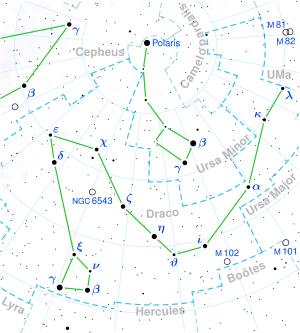Location of G 240-72 in the constellation Draco | |
| Observation data Epoch J2000 Equinox J2000 | |
|---|---|
| Constellation | Draco |
| Right ascension | 17h 48m 07.99282s [1] |
| Declination | +70° 52′ 35.9221″ [1] |
| Apparent magnitude (V) | 14.15 [2] |
| Characteristics | |
| Spectral type | DQP9.0 [2] |
| Apparent magnitude (B) | 14.55 [3] |
| Apparent magnitude (V) | 14.15 [3] |
| Apparent magnitude (R) | 13.5 [3] |
| Apparent magnitude (I) | 13.1 [3] |
| Apparent magnitude (J) | 12.709 ± 0.021 [3] |
| Apparent magnitude (H) | 12.528 ± 0.023 [3] |
| Apparent magnitude (K) | 12.507 ± 0.023 [3] |
| Astrometry | |
| Proper motion (μ) | RA: -1266.387 mas/yr [1] Dec.: 1108.801 mas/yr [1] |
| Parallax (π) | 160.9952±0.0119 mas [1] |
| Distance | 20.259 ± 0.001 ly (6.2114 ± 0.0005 pc) |
| Absolute magnitude (MV) | 15.23 [2] [4] [note 1] |
| Details | |
| Mass | 0.81 ± 0.01 [2] M☉ |
| Radius | 0.00984 [2] [note 2] R☉ |
| Luminosity | 0.000085 [5] L☉ |
| Surface gravity (log g) | 8.36 ± 0.02 [2] cgs |
| Temperature | 5590 ± 90 [2] K |
| Rotation | >100 years [6] |
| Age | 5.69 [note 3] [7] Gyr |
| Other designations | |
| GJ 1221, EG GR 372, G 240-72, LHS 455, LP 44-113, NLTT 45565, WD 1748+708, 2MASS J17480817+7052353 [3] | |
| Database references | |
| SIMBAD | data |
G 240-72 (or WD 1748+708, or LHS 455, or GJ 1221) is a nearby degenerate star (white dwarf) of spectral class DQP9.0, [2] located 20.3 light-years away in the constellation Draco.
